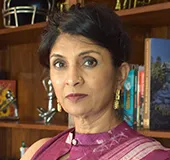
When I was asked to write this keynote on the current Indian startup ecosystem for women in technology, my mind went back not to the recent debates on diversity and gender, but to a woman I had always admired — Sarojini Naidu. I had been rereading about her life. We know of Naidu as a poet and nationalist, but she was also an ardent feminist. She championed the cause of female suffrage and fought against child marriage, bigamy, sati (widow immolation) and for women’s education during tumultuous times. Before Naidu, Savitrabai Phule had defined a path, opening a school for girls in Pune, becoming India's first woman educator.
I studied in one of the first schools for girls in Hyderabad established in 1928 by the visionary Madapati Hanumantha Rao, who was a staunch believer in women’s education. I had a wonderful education and still cherish the values I learnt there, values that I see reflected in someone like Vijayalakshmi Pandit, who was the first woman to be president of the UN General Assembly, one of India’s first women parliamentarians and a political stalwart known for her diplomacy.
Technology provides the means to create and make a difference, which ultimately brings lasting progress and radical transformation.
None of these people were technology stalwarts, and that’s only because their wide-ranging accomplishments were in tune with what society needed at that time. They showed how the vision of even one or two people could have a long-lasting impact. They may have led disparate lives, but they are similar in the fabric of leadership they weaved, and how they pushed the boundaries of innovation in their own ways.
This is like how I view technology. For me, technology is not the goal nor the end result. Technology is an enabler. It provides the means to create and make a difference, which ultimately brings lasting progress and radical transformation. India’s strong tradition of powerful leaders has always given me inspiration and strength, making me believe that despite the many barriers, there are ways to break them.
Technology provides the means to create and make a difference, which ultimately brings lasting progress and radical transformation.
Education and technology have always closely interlinked for me. Growing up, my high school math teacher inspired me to pursue mathematics. I followed this up by studying engineering and computer science, which came naturally to me. This early education enabled me to move to Silicon Valley to engage with cutting edge innovations and technology. Eventually, this led to my initial forays into entrepreneurship. Later, of course, the circle led me back to India and venture capital as a way to engage with my many interests, including being part of the New India story, entrepreneurship, creating economic impact through inclusion and driving job creation.
There was a time when India was merely a back-office for the rest of the world. But in less than a decade, the Indian tech and startup ecosystem has shed that yoke to become the third largest startup hub in the world, behind only the US and China. In the next decade, India can emerge as an innovation hub setting global standards. The vibrancy of our startup ecosystem, which is defining and expanding on India’s goals of inclusion and ushering more people into an inclusive economy, can pave the path:
- India’s startup ecosystem is expected to grow at an annual rate of 12-15 percent
- Of the 50,000+ startups in India, around 9,300 are technology-led startups
- On its website, Startup India states that the number of women entrepreneurs is 14 percent <1>
- In India, six companies have achieved unicorn status in 2020, taking the total tally of unicorns to 37
- India also has 207 ‘soonicorns’ that are on the verge of achieving hyper scale and breaking out, based on Tracxn estimates
These are encouraging figures that show that tech startups have funneled a lot of India’s economic growth in the last few years.
The Indian tech and startup ecosystem has shed that yoke to become the third largest startup hub in the world, behind only the US and China.
Technology matters, now more than ever before. Futurist Ray Kurzweil has made it a habit to make remarkable predictions about how technology will shape the future. We will merge with machines by 2045, he says, pointing to a future where our biology will be made up of equal parts technology and physiology. If technology were to be the backbone of our existence as a species, then it becomes all the more relevant that it is developed with equal participation from women too. There is an urgent need for better gender diversity in technology.
Globally, men dominate the STEM workforce and educational map. When I was doing my engineering in the 1980s, there were only seven women doing the course. Times have changed since then. Every year, on an average, 1.5 million students graduate from engineering courses in India. According to the All India Survey of Higher Education (AISHE) Report 2018-19, India has 993 universities, 39,931 colleges and 10,725 standalone institutions. At the undergraduate level, 51 percent of student enrolment are by males and 49 percent by females across India; for PhDs, it is 56.18 percent by males and 43.82 percent by females; and for integrated levels, it is 57.50 percent for males and 42.50 percent for females. While more needs to be done to encourage more women to continue pursuing their education, there has been good progress over the last few decades. <2> In 1980, Indian women received less than two percent of all engineering degrees, but their numbers have grown since then. On its website, McKinsey notes that unlike many other countries, India’s STEM education map is encouragingly more diverse, with 57 percent of high-performing women having studied in a STEM field in college. <3> In 2018, the AISHE report also found that women received over 31 percent of the engineering and technology degrees. <4>
Positively, women’s earnings are outpacing those of men’s when it comes to high-skill jobs.
In the US, by contrast, the percentage of engineering degrees that women receive has remained relatively static, hovering around 20 percent for years. Despite the increase over the past few decades of women engineers in the STEM workforce, women still account for only 13 percent of employed engineers, according to the US. <5> How much of this is because of unconscious bias, cultural stereotyping, and the inherent difficulties in performing the complex balancing act of being women, mothers, daughters and more? These are questions that do not have easy answers.
But there are positive changes. Today, about 30 percent of researchers worldwide are women, and women hold 26 percent of computing-related jobs. <6> Positively, women’s earnings are outpacing those of men’s when it comes to high-skill jobs. There are many examples that show that women empowerment is beneficial to family and society at large. The Lijjat Papad success story is iconic, growing from an INR 89 enterprise in 1959 to an INR 6.5 billion company. Women have shown that they can create dramatic success stories.
The combined valuation of some of the world’s biggest venture capital-funded companies may well exceed the GDP of some countries.
I am positive that there will be more opportunities for women in technology, and they will play a critical role in the next decade. NASSCOM’s Women and IT Scorecard 2018 report shows that the Indian IT sector is recruiting and retaining more women in leadership roles. <7> It expects nearly half the firms to have a workforce that comprises 60 percent women at the senior level.
Technology has always brought out far-reaching innovation, and more women in tech will offer that vital and much-needed balance to a male-dominated industry. Venture capital will encourage such innovation. It typically creates disruption and enables wealth creation. The venture capital ecosystem in India plays a key role by investing in innovative ideas, helping these ideas achieve product-market fit, and in scaling up. The combined valuation of some of the world’s biggest venture capital-funded companies may well exceed the GDP of some countries. Young startups that struggle to obtain capital from banks have benefited from venture capital firms that offer them the funding to realise their ideas, transforming society in the process. Yet, women-led startups often receive markedly reduced funding.
Women, as partners in investment firms, will lead to a broader set of innovations getting funding.
The total investment in women-led startups is only about 17 percent of the total investment of US$188 billion worldwide. <8> But as more women enter the world of entrepreneurship, that figure will certainly change. Women, as partners in investment firms, will lead to a broader set of innovations getting funding.
We should inspire more women globally to pursue careers in STEM and create the platform and avenues that make it easier for them to achieve that. We need to create clearer pathways for women to enter into STEM careers and stay there. It is, therefore, important to expand the talent pipeline and make gender diversity the core to hiring. We must work diligently to erase any unconscious bias in hiring or promotions. Corporate rewards that highlight progress in objective hiring and policies that are women-friendly need the spotlight and encouragement.
With ease of Internet access, more of India’s young women will adopt greater interest in STEM subjects.
We need to encourage more girls to code and dream of technology from as early as middle school. There is already much progress on this path with non-profits like Reshma Saujani’s Girls Who Code, which encourages women to pursue an education in STEM fields. In India, we have IBM’s STEM4Girls that empowers middle school girls with STEM-related workshops and activities. But there’s scope for more initiatives.
Apart from education, we need to support efforts that offer products that adapt technology to women’s contexts. We need to highlight companies and startups that are using technology to enable women empowerment, education, safety and healthcare. With the Digital India initiative, we are seeing India’s Tier 3, 4, and 5 cities and towns embrace rapid digital innovation. With ease of Internet access, more of India’s young women will adopt greater interest in STEM subjects.
Once the advantages of diversity become more apparent to everyone, a diverse tech environment will be the new standard.
Our world will be different with more women in STEM. Diversity and inclusion are broad buckets, but we need to keep the discussion going. The more conversations we have over this, the more change will follow. Progress will happen in its wake.
From quantum physicists and digital innovators to technopreneurs and AI experts, we are slowly seeing remarkable women in different areas of technology doing what women have always done — radically changing the way we live.
Once the advantages of diversity become more apparent to everyone, a diverse tech environment will be the new standard. Our long tradition of dynamic leadership and meritocracy will create a path for change in our society. Together we can build a stronger, more sustainable innovation economy in India.
Endnotes
<1> StartUp India, Ministry of Commerce and Industry, Government of India, Women Entrepreneurship.
<2> Department of Higher Education, Ministry of Human Resource Development, Government of India, All India Survey on Higher Education 2018-19, (New Delhi: 2019).
<3> Ali Jaffer and Mona Mourshed, “How to attract US women to the sciences, McKinsey & Company, September 1, 2013.
<4> Ministry of Human Resource Development, Government of India, All India Survey on Higher Education.
<5> US Bureau of Labor Statistics, “Labor Force Statistics from the Current Population Survey.”
<6> Daley Sam, “Women In Tech Statistics For 2020 (And How We Can Do Better),” Builtin, March 13, 2020.
<7> Mitter Sohini, “India's IT sector is recruiting more women and giving them leadership roles: NASSCOM,” YourStory, March 13, 2018.
<8> Gené Teare, “2018 Sets All-Time High For Investment Dollars Into Female-Founded Startups,” Crunchbase, January 15, 2019.
The views expressed above belong to the author(s). ORF research and analyses now available on Telegram! Click here to access our curated content — blogs, longforms and interviews.




 PREV
PREV


